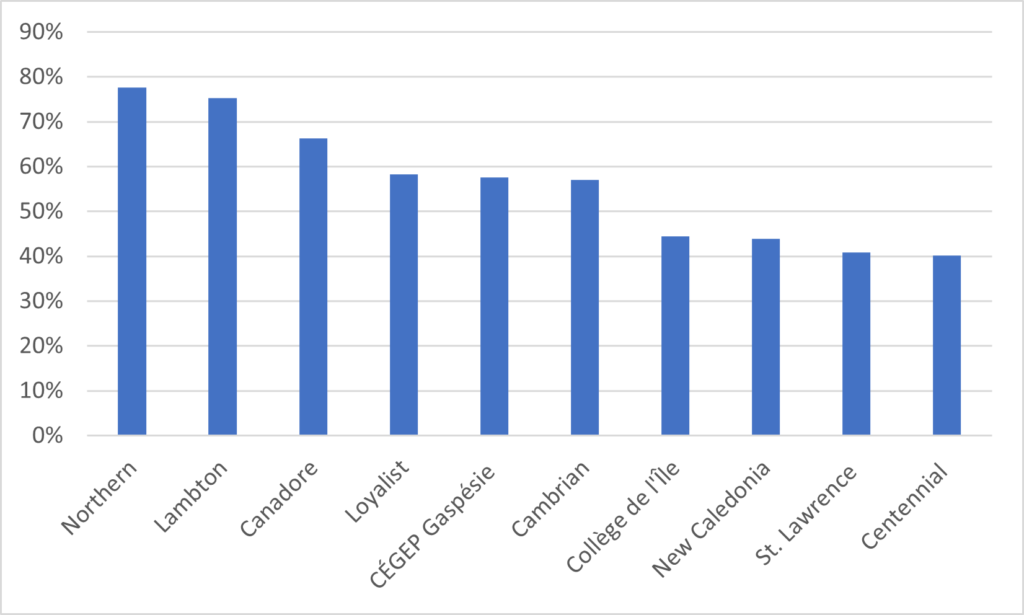A few weeks ago, I realized that I’ve never really written a good blog on where and what international students study in Canada. Think of today’s blog as my way of making amends.
(Note: this is Statscan enrolment data and so refers to enrolments in the fall of 2020, roughly 36 months ago. Assume that things have changed somewhat since then).
Let’s start with the question of what international students study and how this has changed over time. Figure 1 looks at the data for universities, where enrolment patterns have been steady over time even as enrolments have increased. Business is about 25% of all enrolments, with growth mostly at the expense of humanities, health and education, but both science and social sciences kept their shares relatively even. The STEM share here is lower than I would have thought, at about 43%.
Figure 1: International Students by Field of Study, Universities, Canada, 1992-93 to 2020-21

Over to colleges, where it’s a very different picture. Here, business has always been the leading area for enrolments, but this field has shot up enormously in the last few years. It now accounts for almost 50% of all enrolments at the college level, which is most of the growth in student numbers over the past few years.
Figure 2: International Students by Field of Study, Colleges, Canada, 1992-93 to 2020-21

Figure 3 shows that international students in universities are spread across the country in similar proportions as domestic students. Nova Scotia and British Columbia are a little overweight, and Quebec and Alberta are a bit underweight, but basically the spread is similar. However, as figure 4 shows, this is not the case on the college side, where close to 70% of all international students are in Ontario (my guess is by now it is north of 75% and might even hit 80% soon).
Figure 3: Share of Domestic and International Students by Province, Universities, 2020-21

Figure 4: Share of Domestic and International Students by Province, Colleges, 2020-21

Figures 5 and 6 focus on the top institutions for international students. Measured in terms of absolute numbers, the run-away Canadian leader is U of T, with close to 25,000 international students (this puts it close to top of the table internationally, as well, though RMIT and Monash in Australia had similar numbers pre-COVID). However, if we look at the top institutions from the perspective of the percentage of the student body made up of international students (figure 6) we get a different picture: Cape Breton and the Institut national de recherche scientifique top the list with over 60% of students being international. Algoma is third on this list (though given the growth of its Brampton campus I would venture that it probably would be first using 22-23 data and will certainly be so in 23-24). Chicoutimi in fourth place is also a bit of a surprise.
Figure 5: Top Ten Universities by Total International Student Enrolment, 2020-21

Figure 6: Top Ten Universities, International Student Enrolment as a Share of Total Enrolments, 2020-21

Let’s turn now to colleges. Given the data in figure 4, it should come as a surprise to no one that all nine of the top spots in figure 7 are occupied by colleges in Ontario, with only BC’s Langara College breaking up an Ontario sweep. But even without international students, Ontario colleges are among the largest in the country: it simply makes sense that they would also have some of the largest international student bodies (as, indeed, is the case at U of T). More interesting is figure 8, which looks at international students as a percentage of the total student body. Still lots of Ontario colleges, but except for Centennial, all of them are outside the Greater Toronto Area (though these numbers are inflated by enrolments at private GTA-area colleges delivering each college’s curriculum). There are a few interesting entries here: College of New Caledonia in Northern BC, College de l’Île in Prince Edward Island (very low denominator, mind you), and Cegep de la Gapésie et des Îles.
Figure 7: Top Ten Colleges by Total International Student Enrolment, 2020-21

Figure 8: Top Ten Colleges, International Student Enrolment as a Share of Total Enrolments, 2020-21

More tomorrow.

 Tweet this post
Tweet this post

That last graph! Is there any other institution/company/organization/sector (aside from embassies) that is so dependent on people choosing to come to Canada? Even tourism doesn’t hit anywhere near these levels. 10/10 for opportunism and initiative (follow the money). 1/10 for sustainability and robustness.
Thank you for a very interesting picture. Do we have data about the share of enrolment in undergrad vs graduate programs? Maybe that will be in Part 2.
I am very surprised by UQAM in Figure 5. Are you sure that isn’t Université de Montréal (UdeM) rather than Université du Québec à Montréal (UQAM) ?
And if you entered by this article as “PART 1′”
Part 2 is here: —
https://higheredstrategy.com/a-brief-look-at-international-students-in-canada-part-2/